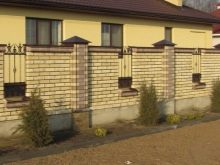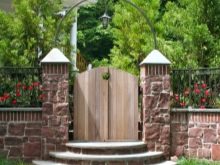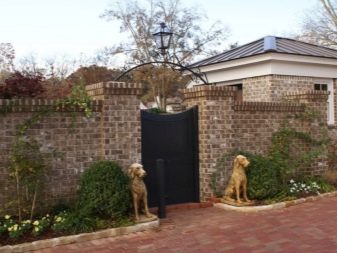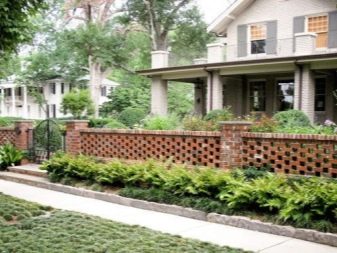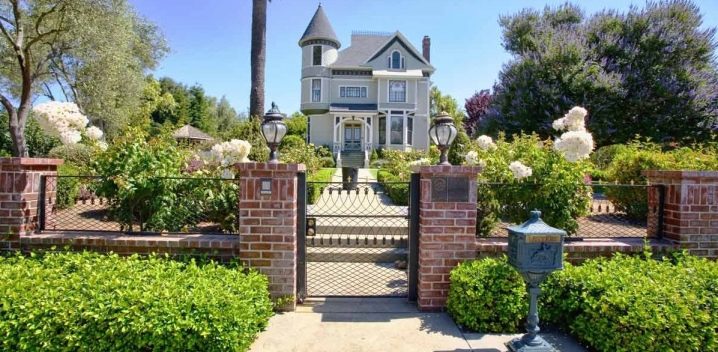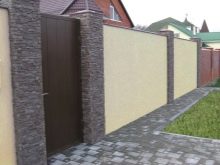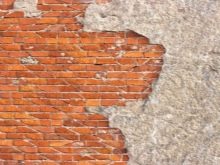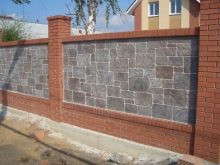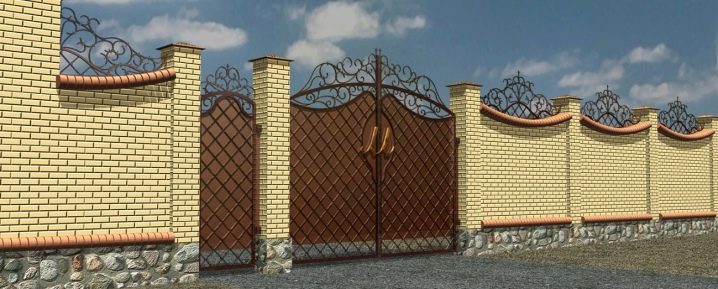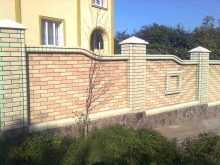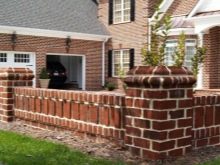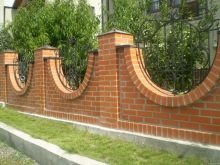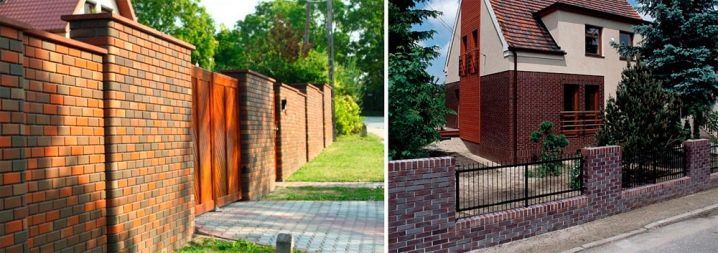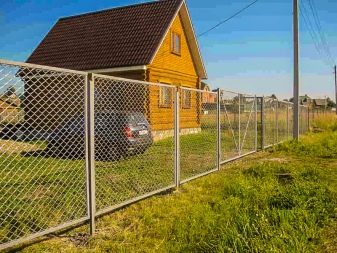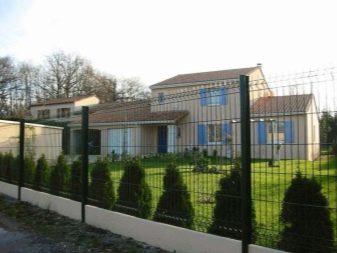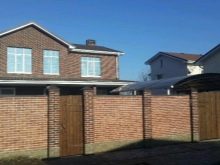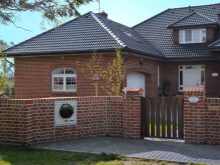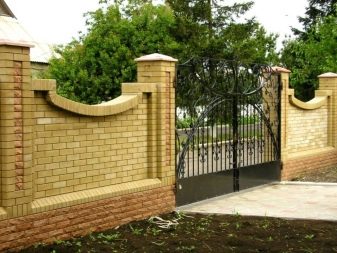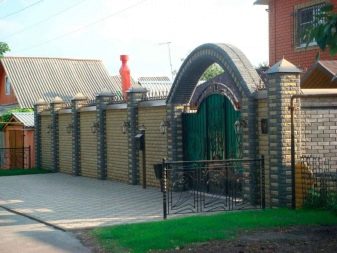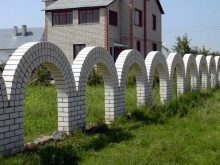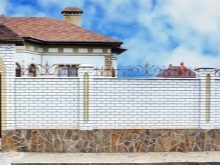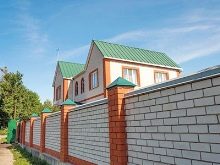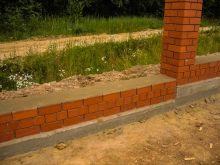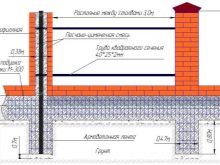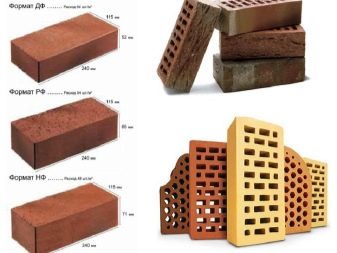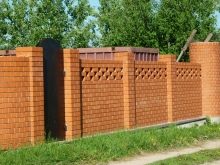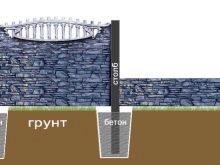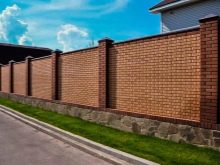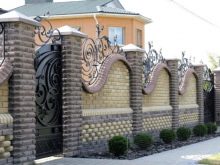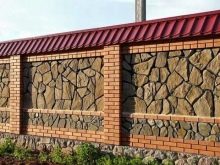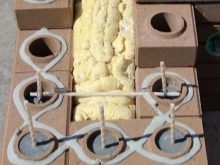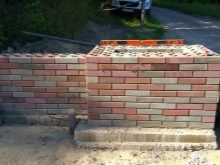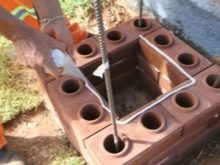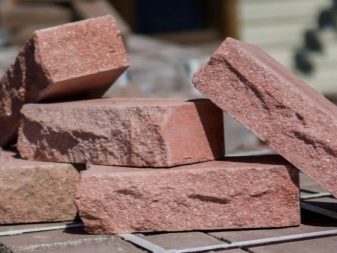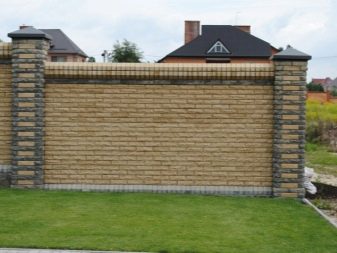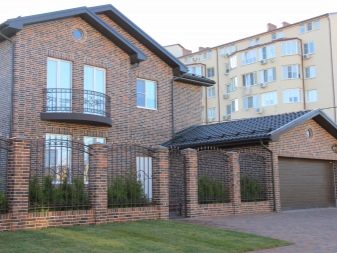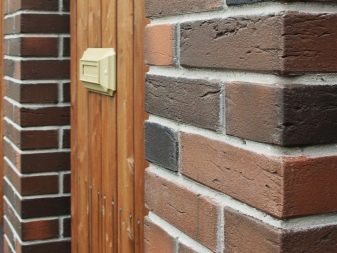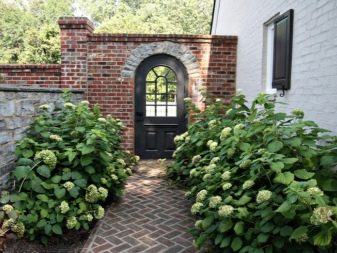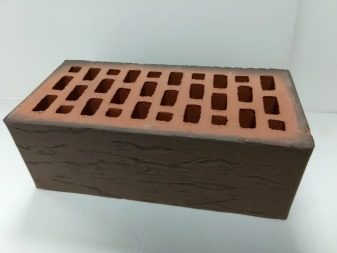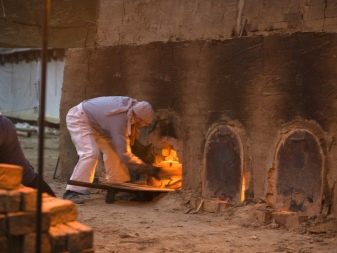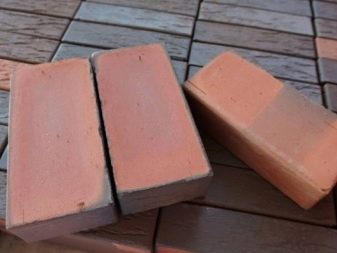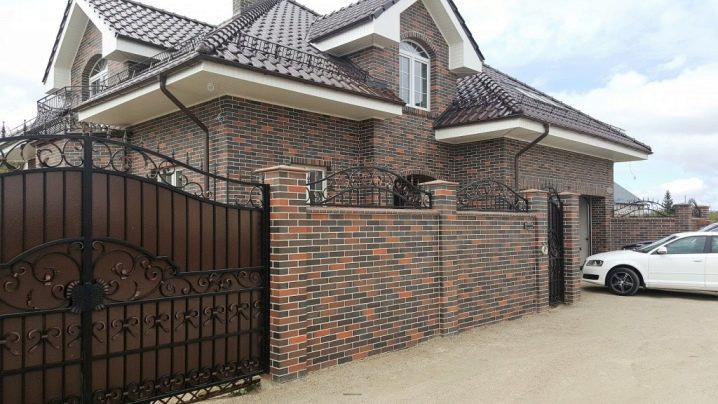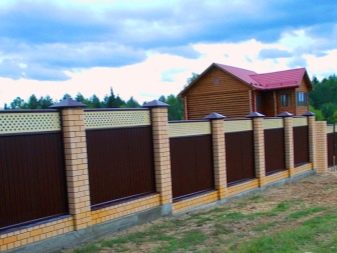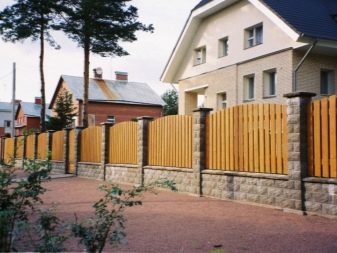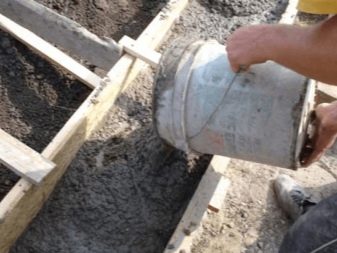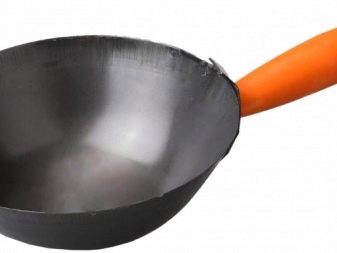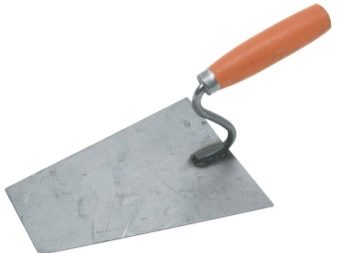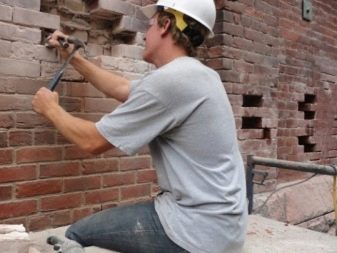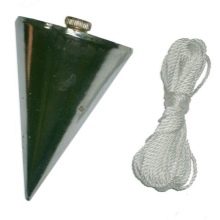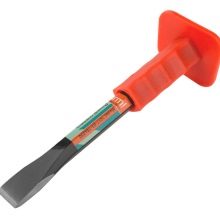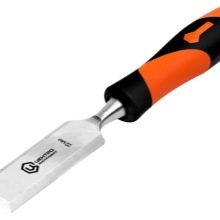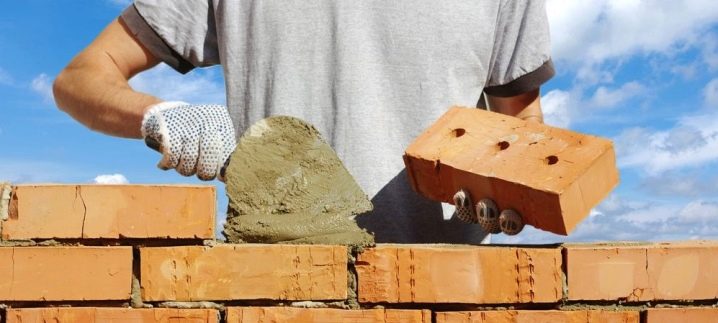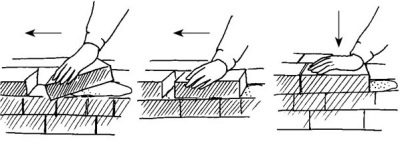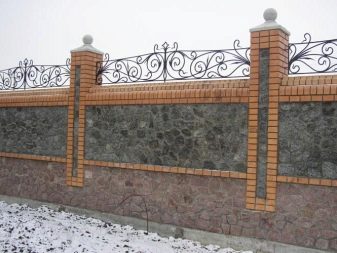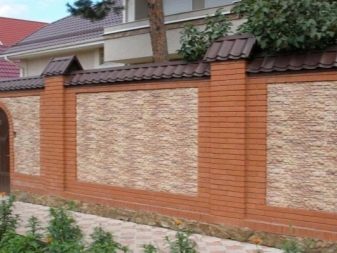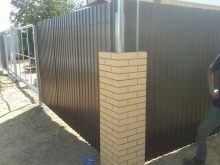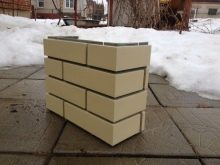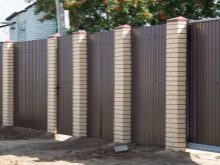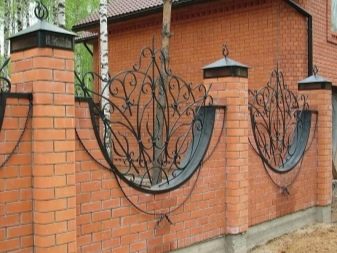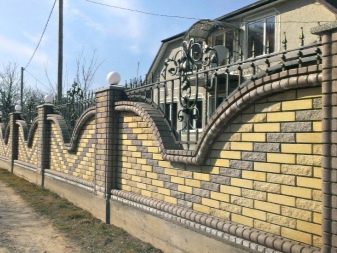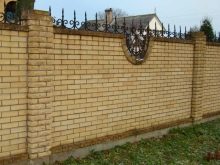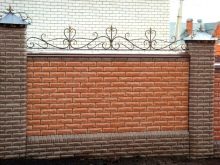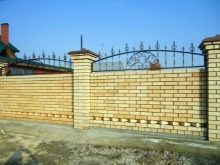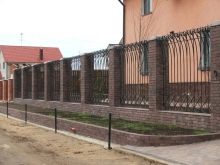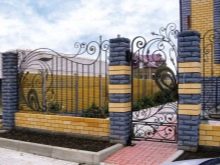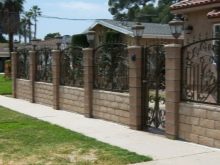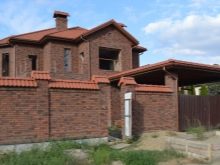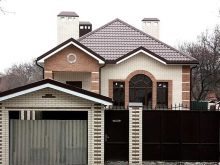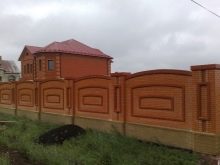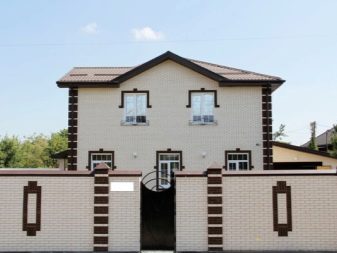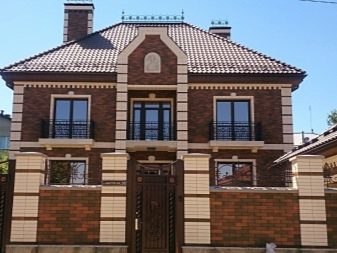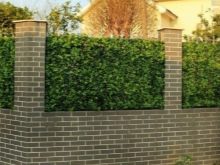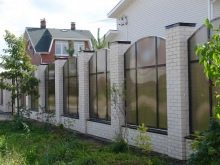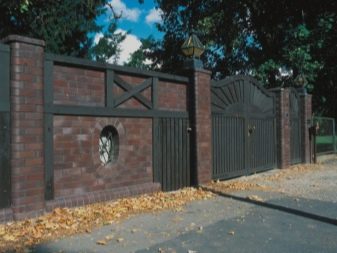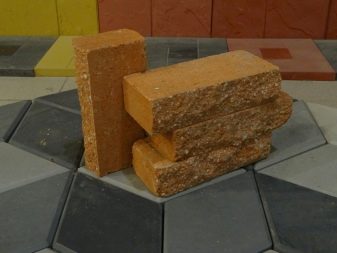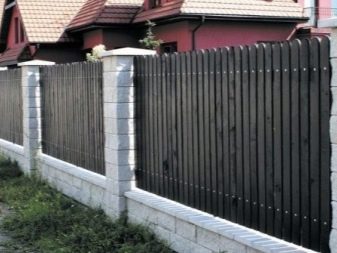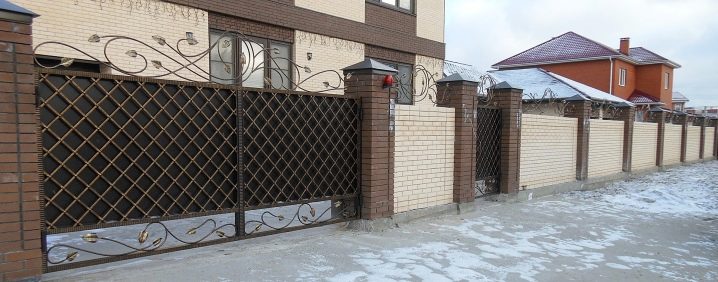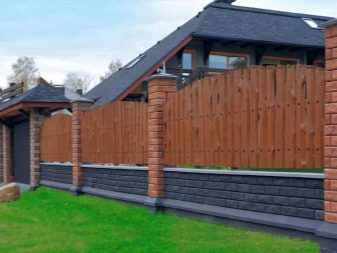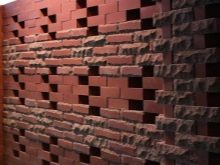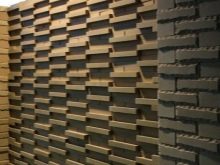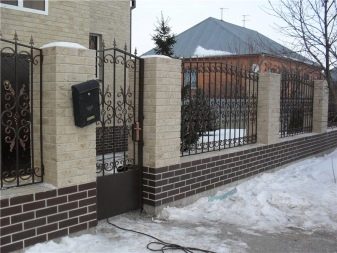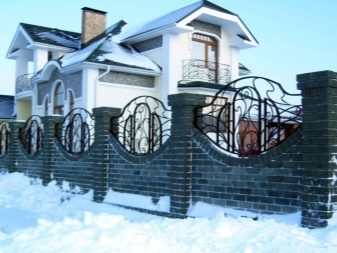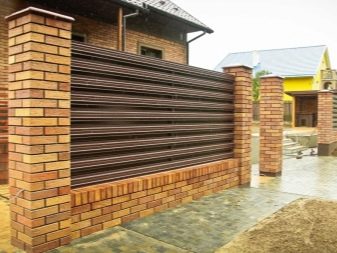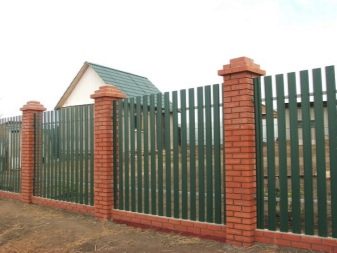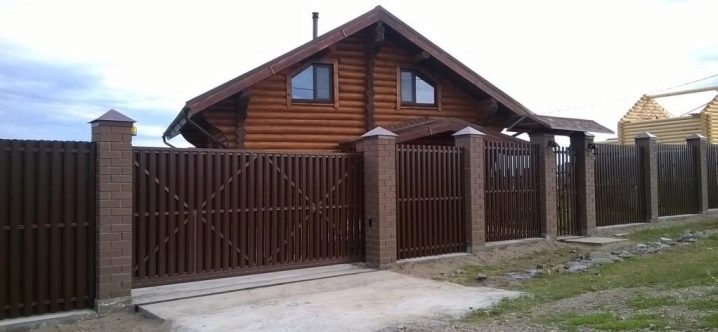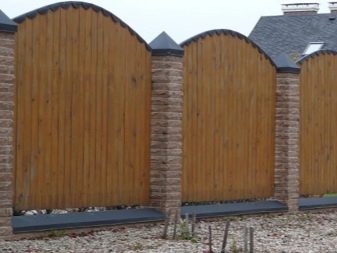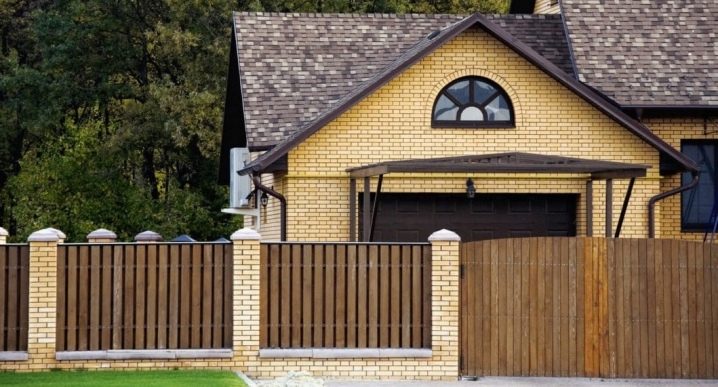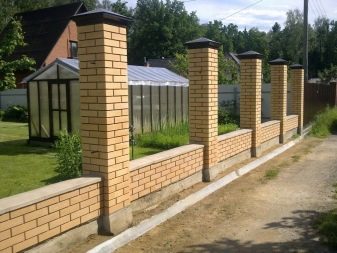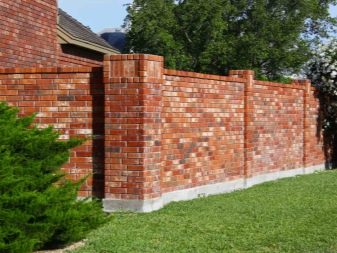Brick fence in landscape design
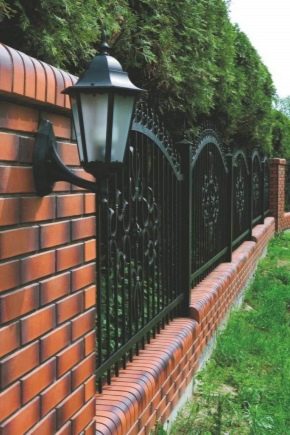
Brick used in the formation of barriers, capital fences for a long time. Its reliability is so great that, prior to the invention of reinforced concrete, only brick structures were a serious alternative to natural stone in fortifications. But people's attention to such a decision is caused not only by its undoubted strength, but also by its external attractiveness. Importantly, people can determine for themselves how high the barrier they need, and what form it will be. Ready-made reinforced concrete slabs, mesh and other such freedom do not give.
Special features
Key advantages of brick fences in comparison with others can be considered:
- excellent durability;
- attractive appearance;
- the possibility of combining with houses and areas, decorated in any style.
The use of facing bricks is recommended when creating decorative masonry. This material is completely ready, does not require additional processing, the variety of its color and texture allows you to realize the most sophisticated design idea.
If you wish, you can add a brick fence with stone, wood, stylish artistic forging. The latter option is advisable if you want to create an environment that is externally interesting and not too catchy.
A universal brick fence can be easily redone if necessary: if necessary, you can quickly increase its height, lower it, and the design will look just as attractive. Both from the outside and from the side of a private house from the courtyard, the appearance will be exactly the same. Depending on the desires of customers, it is possible to issue an additional fence, plastering the masonry or covered with panels corresponding to the dwelling.
However, even the brick which did not undergo additional decoration looks very good.
Calculation of materials
Calculate the exact need for a brick is very important, and it is not particularly difficult. If a wall is made single-layered, a square meter of it is created from 100 blocks, and double-laying requires about 200 bricks in the same area.
Determine the desired height and depth of the barrier; if it is rather decorative, it is permissible to build ½ brick, in which elements are laid with an elongated side along the designated line. But if you want to strengthen the protection of your territory, use at least one and a half bricks.
How much the structure should be high is determined individually: the sizes from 50 to 350 cm are practiced, above the fences they are made only occasionally.
Keep in mind that errors in defining the properties of a fence threaten not only technical, but also legal problems. In some cases, it is better to become familiar with the provisions of the regulations, building codes and regulations. Violating them, for example, in the country, you can get a fine. Or even the order of demolition of an illiterately constructed structure.
All country and garden plots are better protected with structures no more than 150 cm tall, and only from grids or gratings based on various materials.
An exception can be made only with the general consent of the participants of dacha associations, the assembly of which has the right to allow impermeable barriers of no more than 220 cm. These restrictions are due to concern for good lighting of all sections and public roads. If you do not want to limit yourself with a grid, you want to not violate the law, you can indent it deeply so that shading does not actually occur.
Such prohibitions do not apply to individual residential construction at all, except for situations when they operate within the framework of regional law.
If the thickness of the structure is the same, but its shape is different, the material consumption can vary widely. So, on standard 0.06 hectares you can put a square fence (its perimeter is about 98 m), and you can have a triangular one - then the total length of the contours will increase to 112 m. Similar ratios will be for larger territories, the choice of form will not be arbitrary; adapt to the actual configuration of the earth.
The exact calculation is the easiest to do, based on the data of the cadastral plan, then you will not have to do independent measurements.
When using silica brick, the dimensions will be the same as when using the standard version.
To calculate the consumption of concrete for the organization of the foundation for the fence, it is necessary to multiply the width of the base with the height and total length.
Important: above the layer of earth, the concrete must be raised at least 0.1 m.
Intending to build a fence of Slavic bricks, be guided by the size of the products included in your favorite collection. Most often they acquire the so-called “normal” size, single (equal to the traditional) or “euro” (0.7).
Do not forget to calculate the consumption and those materials that are decided to finish the finished fence.
Approximate consumption of raw materials upon receipt of 1 cu. m of concrete is about 3 centners of cement in a handicraft way, 10 centners of washed sand and gravel each. Per cubic meter of brickwork consumes up to 0.3 cu. m of mortar - this figure has already laid the probable loss, inevitable even with very professional work.
If it is decided to create a sectional barrier, they cheat the need for building blocks and concrete solution for single sections and pillars, after which they multiply the result by the required number.
When it is necessary to calculate the need for materials for decorative masonry, the scheme is similar - but it is necessary to make deductions for voids or additions for the eaves, for each tuck and design element.
Types of masonry
Technologists and builders have developed various types of brick laying; one of the most modern and attractive options is considered Lego system. Compared with the use of the classic type of blocks, the speed of work increases significantly, and special training is reduced to a minimum. Simply apply the top row to the bottom in an intuitive way, then glue with construction glue. Lego bricks are hollow inside, which greatly facilitates their transportation and movement directly at the construction site, and reduces the labor intensity of the work.
The use of hyperpressed material is advisable in the case when even the protection provided by the classic type of masonry is insufficient for you. This is a very durable and stable product, and it is crucial that the manufacturer adheres to the technology. If it is broken, then inevitably there will be cracks and defects, even with the most accurate work, and the lifetime of the fence will dramatically decrease.As for the increased thermal conductivity, this indicator has no significant significance in the construction of fences.
Bavarian masonry brick opens up a number of important possibilities; strictly speaking, this is not so much a special method as a specific material. You can see it in any old building, not only in German territory, but also in all other European countries. The essential feature of the Bavarian approach is that the outer side of the material is painted in the most varied tones, forming unusually attractive patterns. For centuries, no efforts of the masters have allowed to create a good monotonous coloring of bricks. And so the lack began to turn in dignity.
What was considered a problem in the past has now completely turned into a characteristic feature of country style or Provence, a way to emphasize the elegance of the old look of the fence.
The Bavarian brick is made using a specific technology; at the end of its roasting, the oxygen concentration in the furnace is increased so that the composition of the clay changes due to chemical reactions. Because the outer layer is painted differently.The vitreous mass in thickness occupies a minimum of 0.2 and a maximum of 0.4 cm. A brick obtained by the South German method, even under the most unfavorable set of circumstances, will not be covered with efflorescence.
The width of the blocks is completely standard, but its appearance has gone far forward in recent years. The engineers managed to figure out how to make the shape of the divorce very intricate, combining these findings with the creation of smooth or textured surfaces.
Experts do not recommend using more than four shades for one part of the fence - this will only complicate the work and the selection of necessary components.
Important: the key color covers at least ½ the entire area, and the remaining two or three tones are distributed in a randomly selected manner, as you see fit.
Erection technology
Most often they use not original design techniques, but quite traditional ways of laying bricks. Diversity is introduced through various geometric structures and individual structural elements. The sectional variant of the fence differs from the continuous one in that the wall is reinforced with supports that are at a distance of 250 - 450 cm.
Since the installation of supports depends on the size of the load, the thinner the created barrier, the less often it is possible to mount columns.
Regardless of whether the considerations of maximum strength or design are put in the first place, the method of work is about the same. First of all, create a markup on which you want to fill the foundation.
To succeed, it is recommended, firstly, to use high-quality concrete, and, secondly, to knead the solutions not by hand, but with the help of mixers, that is, drills with special nozzles.
Other necessary components for work are ladles and trowels. The first are hemispheres with wooden handles and are designed to make the distribution of the solution above the masonry more uniform. Trowels, on the other hand, level the cement, remove its excess at the ends and at the joints, and help saturate the joints with a solution. Careful blows with the back of the tool handle allow you to seat the bricks in exactly the right places for them.
If the fence is supplemented with columns, the accuracy of their placement and the minimum deviation from a straight line is ensured by controlling the corners with a building level.To break a piece of the required size from a brick, professionals advise to use a pickaxe.
The evenness of the facade of the masonry is verified by means of smooth slats from 120 to 200 cm in length. Using the order (rulers of metal or wood, marked with a step equal to the sum of the thickness of the seams and the height of the bricks), you can control the quality of the masonry of a separate tier.
Also, when working using the reference-cone, skeins of twisted cords, chisel, chisel.
When the bricks are laid in the same direction as the entire masonry as a whole, the corresponding strip is called the spoon one, and when perpendicular to it it is called the buttress.
Important: bricks fences can not be made in bricks, only in ½ and above, otherwise they will not be reliable enough!
The pressure calculation requires saturating the vertical joints with mortar using a trowel; Most often, a similar technique is needed to make a full-smooth masonry using a viscous mixture. Initially, a layer of a solution of 15–20 mm is placed 10–15 mm from the border, and then 0.3 to 0.5 cm of the mixture with the bricks of the preceding row are selected and transferred to the sidewalls. Tightly pressing the block with a trowel, they sharply take out the instrument, and with its help they adjust the position of the element in the vertical and horizontal planes.
The butt-laying method implies that the cement mortar is taken not by trowels, but directly by the bricks that need to be laid.
Note: working with the pillars, which will be complemented by a gate or wicket, reinforcement inside the structure should be brought almost to the top. If you do not need to hold any additional elements, you can indent 0.4–0.5 m from the top, there is no risk in that.
In some cases, facade paints, whitewash or plaster are applied on the fences; options with installation of peaks and canopies are quite widespread.
In those cases when you cannot make a full-fledged brick fence (due to lack of funds), you can resort to its imitation - full or partial. Such constructions are made of high-grade polypropylene, resistant to the destructive action of the external environment and at the same time they themselves are environmentally and sanitary safe. In addition to improving the quality of special panels helps applying paint on them, suppressing flaking, fading, slowing down the loss of strength.
Important: the optimal choice of the type of material requires taking into account the weather conditions and the properties of soils in a particular area.
You can learn more about such constructions and methods of their fastening in the following video.
Decor
Brick in combination with forging is perceived very chic; you can use it either as decorating parts or as a functional part of the design. You can vary the configuration and size of the forged blocks, arrange them in an original way.
In the case of a parapet scheme, forged rods and other decorating elements are placed on the inseparable layer of brick.
Important: their height above the top edge of the fence should not exceed 50 cm. Such a solution is outwardly attractive and, in addition, reliably stops most unprepared intruders.
If a plinth (0.3-1.5 m) is placed above the main part of the bricks, very diverse forged blocks are also mounted on top of it. A characteristic feature of this approach is that the fence is transparent.
You can choose a third way in which brick pillars are combined with forged structures. It is forging in this version that accounts for the main part of the length, and bricks can be seen only in columns or pillars. And even the pillars themselves, the columns inside can have reinforcement, which increases their mechanical resistance.
Not only the figured forged element, but also wood can complement the brickwork; Please note that its presence does not always mean an opportunity to save. Most often, such a step is taken, wanting to use a tree that is not needed for other purposes and at the same time to create a spectacular, concise architectural ensemble.
However, even if we confine ourselves to only one brick, a very interesting result can also be achieved. The color solutions are quite varied, and many novice experimenters are puzzled with such a huge choice. Often they try to reproduce the appearance of the facade covering in the house, for example, using shades of red with orange inclusions. Experiments with bricks of brown, yellow, white colors are also widespread.
Wine tonality (Marsala) is perceived very attractively.It is especially good to use such fences as accent elements. It makes sense to use a gray palette in areas designed in modern or urban style; Such coloring is perfectly combined with plentiful use of concrete.
Selecting a combination in a country house, in country ownership, be guided by the color scale of a garden path and platform; In this case, it will be possible to use for the design of the facade of the dwelling not just a different color, but also completely different material.
From the usual and clinker bricks can be built "perforated" fence, built in a checkerboard pattern. Through the gaps one can observe the courtyard and the street, the strength of the structure decreases somewhat, but this is not so significant.
In addition to these options, you can decorate the fence with ordinary plants, imitations, stained glass and ceramics.
Returning to the topic of clinker, it is worth emphasizing that it not only looks very elegant, but also absorbs very little water, does not crumble as long as possible. The fence from it will serve for a long time, and the block can be very diverse in appearance - corrugated, rough, completely smooth. The clinker fence looks optimally on the ultra-modern villas, and in imitations of old estates, even the simultaneous laying out of the walls of the house is permissible.
Using crushed bricks, you can achieve impressive results; The surface of a ragged block is difficult to distinguish from natural stone. It is so nice to present yourself as the inhabitants of a medieval knight’s castle!
The special decoration allows silicate brick to be completely abandoned; it is supplied mostly white for facade installation.It looks nice combination of white pillars with a red or brownish array, or vice versa.
Facade timber (aka decorative timber or planken) is a subspecies of facing bricks; despite the increased price, it is quite reasonable to use it, there will be no risk of destruction of the supports and the entire structure as a whole.
Completes our review of the type of fences, called "bassoon" (literal translation from Italian - an armful of firewood). The appearance reproduces the atmosphere of natural stone, but the surface is sometimes slightly chipped. The mass of one block can reach 4 kg; products with chips about 200 g lighter, and the combination of such options between themselves is very nice.
Combination of materials
Combined fences always look more elegant than made from one type of materials. It is not difficult to increase the sophistication of the fence - it only needs to be added to the brick with artistic forging.
If you use a metal fence, you can save not so little money. At the same time, such constructions serve for a very long time, they are capable of limiting observation from outside of what is happening on the site, but at the same time there is no complete overlap of the review.You can always choose the option that simulates a brick or harmonically combined with the appearance of the home.
The advantage of a shtaketnik made of metal is a high level of security - such constructions cannot be scratched even on purpose.
But those who prefer to complement the fences with wooden type of blocks, including with the help of clapboard, have their own weighty arguments. Taking natural wood, you can significantly improve the soundproofing quality of the fence. Yes, and to stop a strong wind, it will be more efficient than a brick wall.
It should be noted that a wooden canvas, no matter how light it may seem by itself, increases the mass of the fence. And therefore all places where such elements are used will have to be equipped with a more powerful foundation. In the case of massive steel parts, the situation is similar.
Beautiful examples
It is often thought that a brick fence is always a tall and solid construction that looks outwardly indestructible. However, there are completely different options that look very original. For example, a very low boom with pillars raised in several places.However, even with the traditional height of the barrier, its appearance is unique. Here the builders were clearly inspired by the idea of combining moderately red and bleached sections of the wall. They ended up with a great-looking barrage that captured rave eyes.
Another attractive solution is to use expressive dark accents that harmonize in tone with the upper bar, which is placed above all brick rows. It is important not to introduce too many dark elements, otherwise you will get a gloomy look.
Some designers believe that individual bricks do not necessarily have to be straight. Using decorative products of complex geometric shape, you can create a delightful ornament. Its attractiveness will only increase with proper selection of color contrasts with the surrounding details.
Choosing a brick
How to choose the right brick for the construction of the fence, described in detail in the video below.
